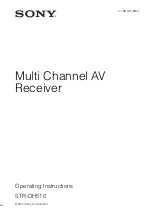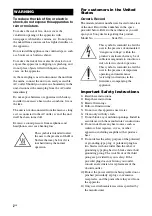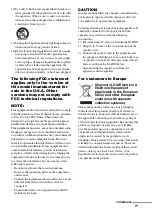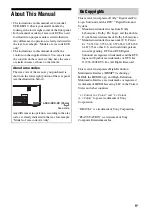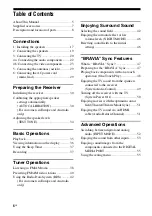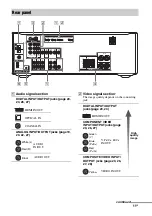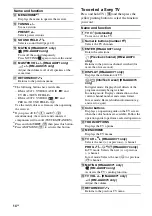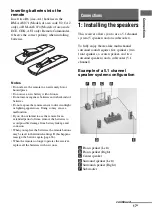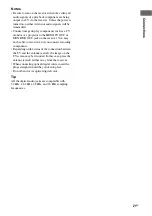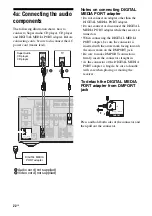
9
GB
Indicators on the display
LFE
L
C
SL
S
PL II
HDMI
DTS
SLEEP
D
.
RANGE
ST
RDS
COAX
OPT
LPCM
SW
R
SR
D
q;
9
8
1
2
3
4
5
6
7
Indicator and explanation
A
Playback channel indicators
The letters (L, C, R, etc.) indicate the channels
being played back. The boxes around the letters
vary to show how the receiver downmixes or
upmixes the source sound (based on the speaker
settings).
SW
L
R
C
SL
SR
S
Subwoofer
Front Left
Front Right
Center (monaural)
Surround Left
Surround Right
Surround (monaural or the
surround components
obtained by Pro Logic
processing)
Example:
Speaker pattern: 3/0.1
Recording format: 3/2.1
Sound Field: A.F.D. AUTO
B
Lights up when the disc being played back
contains an LFE (Low Frequency Effect)
channel and the LFE channel signal is actually
being reproduced.
LFE
L
C
SL
SW
R
SR
LFE
Indicator and explanation
C
Input indicators
Light up to indicate the current input.
HDMI
Lights up when
– INPUT MODE is set to AUTO and the
receiver recognizes a component connected
via an HDMI IN jack (page 23, 52).
– TV input detected Audio Return Channel
(ARC) signals (page 51).
COAX
Lights up when input mode is set to “AUTO” or
“COAX” and the source signals is a digital
signal being input through the COAXIAL jack
(page 52).
OPT
Lights up when input mode is set to “AUTO” or
“OPT” and the source signals is a digital signal
being input through the OPTICAL jack (page
52).
D
DTS
Lights up when the receiver is decoding DTS
signals.
Note
When playing a DTS format disc, be sure that
you have made digital connections and that
INPUT MODE is set to “AUTO” (page 52).
E
Dolby Pro Logic indicators
Lights up one of the respective indicators when
the receiver performs Dolby Pro Logic
processing. This matrix surround decoding
technology can enhance input signals.
PL
PL II
Dolby Pro Logic
Dolby Pro Logic II
Note
These indicators do not light up when the center
speaker and surround speaker is not selected.
continued

